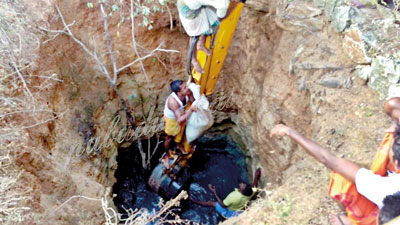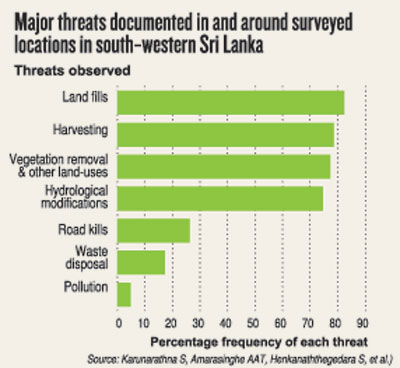News
Terrapins dumped in hellhole
Amidst all the bad news on Sri Lanka’s declining wildlife comes news of an arduous effort to save the lives of 96 trapped, dying terrapins in Katanwewa, Hambantota – a rescue carried out by villagers and wildlife officers attached to Suriyawewa Special Elephant Operations Unit.

Villagers rescuing the terrapin from the abandoned well
Known as kiri-ibba in Sinhala, flap-shelled terrapins (Lissemys ceylonensis) are aquatic creatures that live in streams, lakes and man-made tanks.
The trapped terrapins were found in an abandoned well at a temple near Katanwewa Tank, a small reservoir.
The terrapins did not walk into this hellhole but had been thrown in by fishermen who fish in the Katanwewa Tank. Terrapins that became entangled in the fishermen’s nets were thrown into the well as the fishermen resented them eating the fish in the tank. Over time, nearly 100 terrapins became trapped in the well.
As drought sniffed the air of Hambantota, the water level in the well started going down, leaving a smelly, muddy sludge and the terrapins began dying from the unbearable living conditions. The villagers alerted the Department of Wildlife.
The wildlife team first pumped the remaining water out of the well and then used a backhoe to widen it. Ignoring the stink of the mud and rotting terrapin carcasses a few villagers descended into the well on the arm of the backhoe and began picking up to the terrapins, which by this time were fully immersed in the mud. The terrapins were put in gunny bags and taken out of the well.
They were later released at Bundala.
Although these terrapins were lucky to be thrown a lifeline, the “ibbas” of Sri Lanka face many threats. Sri Lanka is home to two aquatic terrapins, sometimes called freshwater turtles: the species rescued at Katanwewa and the Indian black terrapin (Melanochelys trijuga thermalis) known in Sinhala as gal-ibba.
“Slaughter for meat is a major threat to terrapins. Modification of aquatic or wetland habitats and pollution of waterways also threaten their existence,” reptile specialist Sameera Suranjan Karunarate said.
Although statutory protections prohibit collection, killing, and trade of terrapins or their eggs, the enforcement of these regulations outside protected areas is non-existent, he added. The increase in the Chinese workforce, which has a special yen for these creatures, heightens the risks to the terrapins’ survival.
Terrapin populations outside protected areas are at risk as evidenced by lower population densities amid a multitude of human threats.
A survey of 79 freshwater habitats outside protected areas in the Southern Province found low numbers of both species. Mr. Karunaratne and a research team found Indian black terrapins in just half of the surveyed sites and flap-shelled terrapins in only one-third of the sites.
This survey included questioning of residents around the waterways. Only one-fifth of respondents believed in the environmental benefits of terrapins, a significantly lower number than those who considered that the only use of terrapins was as a source of meat.
A high proportion of respondents (70 per cent) was unaware that native terrapins were protected by the Fauna and Flora Protection Ordinance. A significant proportion of the local inhabitants (87 per cent) said that, from their observations, terrapins were declining in numbers.
Sri Lanka is also home to star tortoises, essentially land-dwelling creatures equipped with broad front legs with strong claws and stubby, club-shaped rear feet like elephants, which are categorised as “near threatened”.
Customs officials have recently intercepted large hauls of tortoises and terrapins being smuggled out of the country.
There is one terrapin that is a problem: Sri Lankan waterways are filling with the invasive red-eared terrapin imported as a pet. Mr. Karunaratne said the research team observed this invasive species in a number of surveyed aquatic habitats.

